Finding an injured bird of prey:
According to article 67 of the Law on the conservation and promotion of wildlife (L.R.Q., c. C61.1), all bird of prey found injured or dead must be reported to a wildlife protection agent.

Evaluating the situation:
Before capturing the bird for sending him to the Birds of prey Clinic, make sure that the bird really needs help. If it is a younster, communicate with us before capturing the bird.

Capturing the bird:
Before approaching the bird, prepare a pair of gloves, a blanket and a transportation box in order to minimize the handling time and therefore the bird's stress. For the transportation box, avoid mesh cages. Instead, use a plastic or a cardboard box with holes. If possible, use shredded paper at the bottom of the box for bedding.
Always wear gloves to capture the bird of prey. Cover it with the blanket, and take control of the bird's legs. Once the legs have been immobilized, take the bird (one hand holding the bird's legs, the other on the bird's back to keep hold its wings against its body) and put it in the box.

Transport to the Birds of prey Clinic:
If you can, bring the bird to the Birds of Prey Clinic of the Faculté de médecine vétérinaire of the Université de Montréal in Saint-Hyacinthe. First, call us to make sure that somebody will be available to meet you (450-773-8521 extension 8545). If you cannot transport the bird, you can call the nearest point of service of the Ministry of Natural Resources and Wildlife (go to http://www.mrnf.gouv.qc.ca/nousjoindre/nousjoindre-faune.jsp#regions).

Medical Examination:
Upon arrival, the veterinarian on duty will examine the bird by doing a complete medical exam. Hence, the veterinarian can find visible wounds or injuries and make a preliminary diagnosis. The veterinarian usually has only limited information at the bird's arrival, and thus will do an exhaustive examination of the animal.

Care/Surgery:
Once a diagnosis has been established, the veterinarian can choose for an adapted treatment (bandage, fluids, medication, etc.). Surgeries are not uncommon because an important proportion of the birds that are received are suffering from traumatic injuries (after being hit by a car for example).

Recovery in aviary at the Birds of prey Clinic:
During the whole healing process, the injured birds are kept in seperate aviaries. The aviaries are closed and are located far away from human circulation to reduce the stress on the birds. The treatment periods are set up to be as quick as possible. Indeed, the birds of prey being wild animals, (and therefore afraid of humans) they do not appreciate their stay in the hospital.

Rest and physiotherapy at Chouette à voir!
Once a bird has healed from its injuries, it is transfered to our rehabilitation complex in Saint-Jude at Chouette à voir! (see heading Chouette à voir!). These aviairies are much bigger and in addition they are located in a natural setting. They are therefore ideal to allow the bird to get back into shape before it is released. They also allow the veterinarians to come and watch the bird fly to determine whether it is ready to be released in the wild.

Final medical exam:
When the day has come for the bird's release, it is captured by the veterinarian and undergoes a final medical exam. We make sure that no medical problems have gone unnoticed during its stay at the clinic. If a problem is found, the release is postponed. If everything is fine, the veterinarian will sharpen the bird's beak and the its claws, that often become dull during its captivity, to give him back the tools it needs to hunt properly.

Banding:
Just before the bird's release, the veterinarian will put a ring on its leg. On this ring there is an identification number and a number to call if the bird is found injured, dead or captured by biologists during the course of sampling. This will allow us to have valuable information in order to help us better understand their biology and migratory movements.

Release:
Everyone's favorite moment! Of the 350 injured birds of prey that we get on average each year, 40 to 45% of them are released back into the wild. The other's unfortunately die from their injuries or remain in captivity if they suffer from permanent injuries that would prevent them from being able to hunt (e.g. a wing amputation). UQROP is not financed to do this work. If you wish to contribute to this cause, scroll over the dropdown menu "About us", and discover different ways of helping us by scrolling over the submenu "Support/Get involved"
Help us help them!









